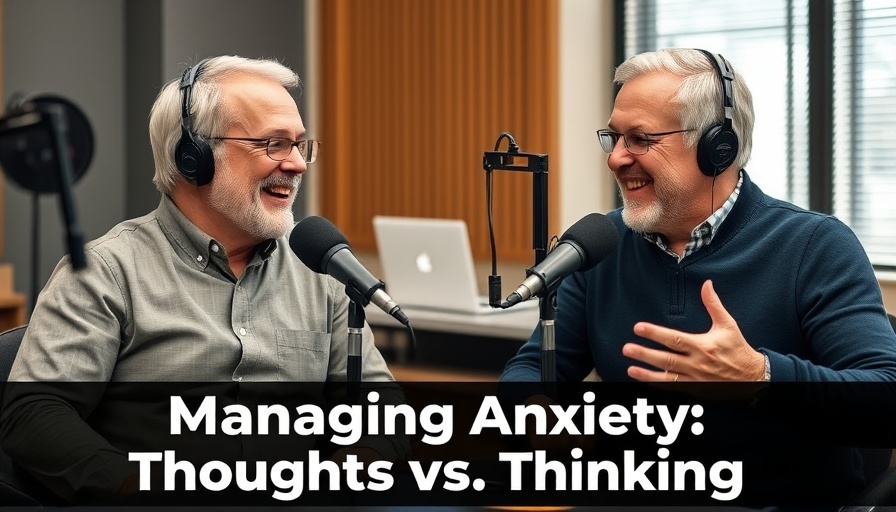
Understanding the Anxiety Puzzle: Thoughts vs. Thinking
When it comes to managing anxiety, distinguishing between thoughts and thinking can be crucial. This distinction, often overlooked, can lead to greater understanding and effective management of anxiety symptoms. Josh Spitalnick, Ph.D., breaks down these concepts in a compelling way, shining a light on how they relate to anxiety disorders. In his discussion, he introduces the idea of the "W's of level two thinking" - who, what, where, when, why, and how. These questions can provide insights into the way we approach our worries.
In "The Key to Managing Anxiety: Thoughts vs. Thinking," Dr. Josh Spitalnick explores how understanding the distinction between thoughts and thinking is essential for effective anxiety management, prompting us to dive deeper into this topic.
The W’s of Anxiety: Are You Asking the Right Questions?
Doctor Spitalnick mentions that when individuals with anxiety ask questions starting with W, they aren't just worrying; they're trying to handle uncertainty. For someone with social anxiety, this might manifest as questioning whether they’ll face laughter during a speech. For others, it could be the dread of encountering a snake while hiking. These questions often reflect an attempt to mitigate anxiety by seeking clarity in the face of fear.
Worrying: A Double-Edged Sword
While during discussions about anxiety, it may appear that those who worry are simply sifting through their thoughts, for many, this is a deeper issue. The act of worrying isn't just idle concern; it can become a compulsion that prevents individuals from moving on with their lives. Doctor Spitalnick elegantly points out that for some, worrying becomes a mental ritual—an incessant cycle of forecasting future events with the fear of what could happen. This is the anxiety epidemic that traps many individuals in a loop of overthinking.
Symptoms Simplified: T’s, O’s, and C’s
To facilitate better understanding and management, Spitalnick categorizes symptoms into triggers (T), fears (O), and safety behaviors (C). Triggers provoke anxiety responses; fears represent internal struggles such as racing heart or panic; and safety behaviors are specific actions taken to avoid or mitigate anxiety. Knowing these categories is essential for therapists and patients alike, as they pave the way for effective treatment strategies.
The Science Behind Anxiety: It’s All in the Brain
Understanding anxiety involves delving into neuroscience. The prefrontal cortex and limbic system’s communication—or lack thereof—significantly impacts our emotional well-being. Anomalies within these brain regions can lead to disruptions in how we process fear and anxiety. Knowing this enables us to adopt better coping strategies, enhancing our overall approach to managing anxiety.
Future Trends: Insights into Anxiety Management
As our understanding of anxiety evolves, the incorporation of cutting-edge health research and science-backed health tips becomes vital. Integrating psychological insights with recent findings in neuroscience provides a comprehensive foundation for developing more personalized health strategies. These advances pave the way for innovative therapeutic practices that could redefine how we think about and treat anxiety disorders in the near future.
Taking Action: What Can You Do to Manage Anxiety?
Firstly, pay attention to your thoughts. Learn to differentiate between mere thoughts and constructive thinking. Have you found yourself in a cycle of worry? Consciously redirect your focus to productive problem-solving rather than ruminating on what could go wrong. Moreover, consider incorporating healthy lifestyle changes. Engaging in regular exercise, establishing a balanced diet, and exploring biohacking tips focused on cellular health can bolster resilience against anxiety.
Conclusion: Let’s Tackle Anxiety Together
In summary, the video "The Key to Managing Anxiety: Thoughts vs. Thinking" serves as a powerful reminder that understanding the nuances of our cognitive patterns can empower us to tackle anxiety more effectively. If health optimization and longevity pique your interest, consider deeper engagement with professionals that specialize in these fields. The journey to overcoming anxiety need not be navigated alone; a collaborative effort towards improved mental health can make all the difference.
 Add Row
Add Row  Add
Add 




Write A Comment